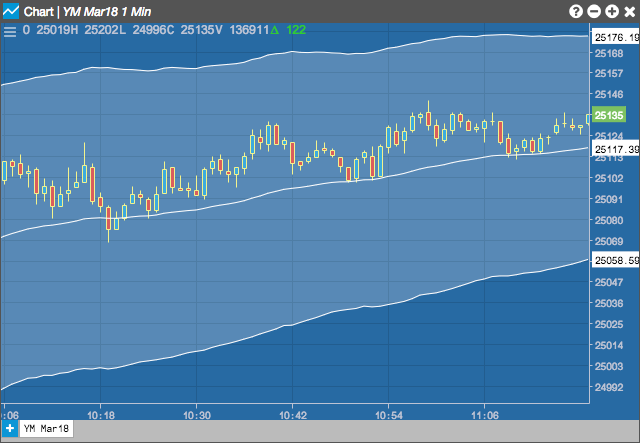チャート
ケルトナー チャネル (KC)
ケルトナー チャネル (Keltner Channel) は、1960年に Chester W. Keltner の著書 「How To Make Money in Commodities」 (商品先物で儲ける方法) にて紹介されました。またペリー・カウフマン (Perry Kaufman) の著書「The New Commodity Trading Systems and Methods」 (ニュー トレーディング システム アンド メソッド) でも解説されています。ケルトナー チャネルは、単純移動平均 (通常、高・安・終値の平均値の移動平均) と 、この移動平均線の上下に描画されたバンドの、3本の線で構成されています。バンド幅は アベレージ トゥルー レンジ に任意の乗数を適用したもので、この結果を中央の移動平均線に、足し引きして描線します。
価格がチャネル線を越えると、市場の方向に基づいて、ある種の変化が発生していることを示します。
- 不活発な市場では、バンドを超過すると、過剰売りの市況を示しています。
- 高騰市況では、上部の境界線を越えるとブレイクアウトの可能性を示します。
- 下降市場では、下部の境界線を越えると、ある種の市場の弱みを示します。

Configuration Options

- Period (ピリオド): 計算で使用されるバー数。
- Shift (シフト): バンドを描画する移動平均より上と下のアベレージ トゥルー レンジ数。
- Moving Average Type: Type of moving average to use in the calculations:
- Simple: Mean (average) of the data.
- Exponential: Newer data are weighted more heavily geometrically.
- Time Series: Calculates a linear regression trendline using the “least squares fit” method.
- Triangular: Weighted average where the middle data are given the most weight, decreasing linearly to the end points.
- Variable: An exponential moving average with a volatility index factored into the smoothing formula. The Variable Moving average uses the Chande Momentum Oscillator as the volatility index.
- VIDYA: An exponential moving average with a volatility index factored into the smoothing formula. The VIDYA moving average uses the Standard Deviation as the volatility index. (Volatility Index DYnamic Average).
- Weighted: Newer data are weighted more heavily arithmetically.
- Welles Winder:The standard exponential moving average formula converts the time period to a fraction using the formula EMA% = 2/(n + 1) where n is the number of days. For example, the EMA% for 14 days is 2/(14 days +1) = 13.3%. Wilder, however, uses an EMA% of 1/14 (1/n) which equals 7.1%. This equates to a 27-day exponential moving average using the standard formula.
- Hull: The Hull Moving Average makes a moving average more responsive while maintaining a curve smoothness. The formula for calculating this average is as follows: HMA[i] = MA( (2*MA(input, period/2) – MA(input, period)), SQRT(period)) where MA is a moving average and SQRT is square root.
- Double Exponential: The Double Exponential moving average attempts to remove the inherent lag associated to Moving Averages by placing more weight on recent values.
- Triple Exponential: TBD
- Simple
- Exponential
- Time Series
- Triangular
- Variable
- VIDYA
- Weighted
- Welles Winder
- Hull
- Double Exponential
- Triple Exponential
- Channel Fill (チャネル フィル): 上部バンドと下部バンド間の部分を網掛け表示するかどうかを決定します。
- Color Selectors (配色セレクター): グラフ要素に使用する配色。
- Display Axis Label (軸ラベルの表示): Y 軸に最新値を表示するかどうか。
数式
\[中央線 = MA_{n}\;of \frac{(高値 + 安値 + 終値)}{3}\]
\[上部バンド = 中央線 + ( y * ATR)\]
\[下部バンド = 中央線 - ( y * ATR)\]
場所:
\[MA_{n} = User\;defined\;moving\;average\;of\;n-periods\] \[y = Shift = factor\;applied\;to\;the\;ATR\] \[ATR = Average\;True\;Range\;of\;n-period\]